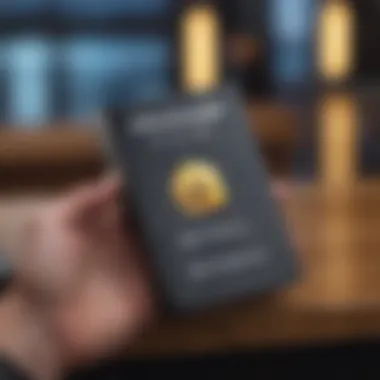How to Verify Your Blockchain Wallet Address Effectively


Intro
In the world of cryptocurrency, verifying your wallet address is not just a best practice—it’s essential. With cyber threats lurking around every corner and the irreversible nature of blockchain transactions, ensuring the accuracy of your wallet address cannot be overstated. Even the most seasoned crypto enthusiasts have, at some point, faced the daunting task of confirming their wallet address. One wrong character in the address, and your funds could head into the ether.
This section aims to demystify the process of checking your blockchain wallet address. So, let’s dive into the fundamental aspects of cryptocurrency, helping you get a solid grasp on the factors that make address verification crucial.
Understanding Blockchain Wallet Addresses
In the ever-evolving landscape of cryptocurrency, blockchain wallet addresses stand as a crucial pillar for secure transactions. This section delves into their definition, significance, and the individual components that form these addresses, providing clarity to both novices and seasoned investors alike. The deeper one understands these wallet addresses, the better equipped they become to navigate the complexities of the blockchain world.
Definition and Importance
A blockchain wallet address acts as a unique identifier for a user on the blockchain network. Think of it as a digital mailbox where users can send and receive cryptocurrencies. Each address is generated from a cryptographic algorithm and is essential for conducting transactions, ensuring funds reach the correct destination.
The importance of correctly understanding wallet addresses cannot be overstated. Misplacing a character while entering an address can lead to lost funds—potentially irreversible losses. Therefore, the significance lies not just in knowing what an address is, but fully grasping how it functions, the risks associated with it, and the best practices for using it. This understanding forms the foundation of safe and effective cryptocurrency management.
Components of a Wallet Address
A blockchain wallet address is not just a random string of characters; rather, it comprises several essential components that work together to ensure both security and functionality.
Public Key
The public key is a vital element in the cryptocurrency ecosystem. It acts like a bank account number, allowing others to send cryptocurrencies to your account without exposing sensitive information. The key characteristic of the public key is its openness; it can be shared without compromising security. This transparency makes it a reputable choice for addressing, as users can easily share their public key for transactions.
One unique feature of the public key is its derivation from the private key using a one-way cryptographic function. This means that while it is easy to generate a public key from the private key, the reverse is not possible, offering a layer of security. However, its greatest disadvantage is its susceptibility to phishing attacks if shared somewhat indiscreetly.
Private Key
In contrast, the private key represents the more sensitive part of the wallet's components. It is akin to a PIN code or a password. Its primary role is to authorize transactions and provide access to the wallet’s contents. The private key must be kept confidential, as anyone with access to it can drain the wallet's funds. This key characteristic makes it a crucial and high-risk feature of wallet security.
The unique aspect here is that, unlike the public key, the private key should never be shared with anyone. Even a seasoned cryptocurrency trader can fall into the trap of phishing if they inadvertently disclose their private key. Managing private keys effectively, along with securing them adequately—such as using hardware wallets—becomes an imperative for ensuring security.
Address Formats
Wallet addresses come in various formats, which helps to streamline operations across different blockchain technologies. For instance, Bitcoin addresses often use Base58Check encoding, while Ethereum addresses utilize a hexadecimal format prefixed with '0x'. The diversity in address formats serves to enhance usability across various platforms.
A notable feature of address formats is their built-in checksum, which helps reduce errors. This minimizes the chance of losing funds due to typos or incorrect entries, reinforcing their reliability. However, the complexity of different formats can lead to confusion, particularly for those unfamiliar with the specific requirements of each blockchain.
Understanding these components in detail is critical for anyone looking to dive deeper into the world of cryptocurrency. Wallets are not merely digital repositories; they are intricate systems that demand respect and knowledge to utilize effectively without falling victim to its pitfalls.
Always remember: a blockchain wallet address is your gateway to cryptocurrency, but knowing how to manage and secure that address is key to avoiding potential pitfalls.
Common Methods for Checking Wallet Addresses
The realm of cryptocurrency is like a wild west, where one wrong move can cost you dearly. Hence, knowing how to check your wallet address correctly holds substantial importance. Doing so helps prevent mishaps like sending funds to an incorrect or fraudulent address, something that can feel like throwing your money into a black hole. In this section, we will explore two prevalent methods for addressing verification. Each method boasts its own set of benefits and caveats, catering to varying user needs and technical expertise.
Using Crypto Wallet Applications
Built-in Verification Features
Many crypto wallet applications come packed with built-in verification features. These tools serve as a buffer, ensuring that the address you are about to use is valid and conforms to the required format. One key characteristic is that they generally perform checks in real-time as you enter the address. This active feedback makes it a popular choice among users who may not be well-versed in technical aspects.


A unique feature of these applications is the address validation, which checks for common mistakes, like truncated or extra characters. This adds an extra layer of security, reducing the chances of human error. However, a disadvantage is that not all wallets include comprehensive address validation; some may only focus on format without checking for the existence of the address itself. Users should therefore pick their wallet with care to ensure they have access to such features.
Manual Entry Check
Manual entry checks are another option that many individuals resort to. This method involves carefully inputting your address into a separate verification tool or blockchain explorer to confirm its validity. The key charm of manual entry is its versatility—it's a viable option regardless of whether you're using a complex wallet application or not. For those who appreciate being hands-on, this method might feel more reliable.
A unique aspect is that manual entry allows for immediate interaction with the blockchain explorer. Once input, users can quickly assess not only the address’s format but also its transaction history. Nonetheless, this method comes with its own set of pitfalls. As simple as it sounds, typing errors could lead to invalid searches, and the user needs to be extremely attentive during the entry process. While it empowers users, it also places the onus on them to double-check their typing each time.
Blockchain Explorers
Overview of Blockchain Explorers
Blockchain explorers act like public ledgers, visible to anyone who wishes to look. Think of them as search engines for blockchain data—providing insights not just into wallet addresses, but entire transactions, blocks, and more. They serve as an incredibly vital tool for those needing deeper trust and verification in their system.
The benefit of using a blockchain explorer lies in its transparency. The public access to this information ensures that anyone can verify funds, making it a robust choice for users concerned about security. Users can also gauge the address's functionality by reviewing its transaction history. However, while they are great for confirmation, they can sometimes be confusing for newcomers; the amount of data presented can be a tad overwhelming without prior experience.
Step-by-Step Usage
Using a blockchain explorer is straightforward, and it can be broken down into simple steps. First, launch the explorer site, such as etherscan.io or blockchain.com. Next, paste your wallet address in the search bar. Finally, hit the search button to pull up transaction data. Each of these actions crystalizes the user’s understanding of their wallet activity quickly.
The beauty of this step-by-step usage lies in its clarity, but be mindful; not every explorer covers every currency. Some are specific to cryptocurrency types, meaning one could end up utilizing the wrong explorer. Users need to choose wisely to connect with the correct blockchain for their asset.
Always ensure you are using a trusted explorer as some might not provide accurate or updated data.
Overall, both wallet applications and blockchain explorers stand out as effective methods for checking wallet addresses. Familiarity with either can not only protect your assets but enable you to navigate the blockchain landscape confidently. Recognizing their strengths and weaknesses allows you to make informed choices, ultimately enriching your experience in this evolving financial ecosystem.
Security Implications of Checking Addresses
When it comes to navigating the intricate world of blockchain and cryptocurrency, the significance of security cannot be overstated. With every verification of your wallet address, there are risks lurking around each digital corner. The focus on the security implications of checking addresses is not merely a precaution; it's a necessity for anyone engaged in the crypto space. By understanding the threats associated with wallet address verification and adopting best practices, one can immensely lessen the chances of falling prey to phishing scams or other illicit schemes.
Risks of Phishing Attacks
Phishing attacks are one of the most prevalent threats in the cryptocurrency realm. These deceptive tactics aim to mislead individuals into divulging their sensitive information or sending funds to fraudulent wallet addresses.
Avoiding Deceptive Websites
Being alert about deceptive websites is fundamental in foiling phishing attempts. Many scams utilize websites that closely mimic legitimate services, making it complicated for average users to distinguish them. A key characteristic of deceptive websites is their URLs which often feature subtle misspellings or extra characters. For example, a site like may be impersonated as . This slight alteration can lead to substantial losses.
To protect oneself, it is crucial to always type the URL manually instead of clicking on links from emails or messages. Bookmarking critical sites is also a wise move, as this allows you to reach them directly without missteps. Therefore, opting for verified resources contributes significantly to reducing risks.
Importance of Secure Browsing
The importance of secure browsing cannot be brushed aside. Utilizing a secure connection means employing HTTPS instead of HTTP. This level of security encrypts the data you send and receive, making interception by malicious actors far more challenging.
Secure browsing is beneficial as it enhances trustworthiness and ensures more protection during transactions. One unique feature to look for while browsing is the padlock icon in the address bar. Clicking on it may reveal the details of the security certificate, adding another layer of reassurance. Nevertheless, secure browsing should be coupled with awareness of other threats, as it is just one line of defense in the entire strategy against online risks.
Ensuring Privacy and Anonymity
In today’s digital landscape, privacy is a treasure worth guarding. Ensuring your online activity remains anonymous is crucial, particularly in highly scrutinized fields like cryptocurrency. Taking the appropriate steps can help keep one’s information under wraps, providing peace of mind.
Using VPNs or Tor
Utilizing Virtual Private Networks or Tor is an effective method for enhancing privacy. These tools mask your IP address, making it far harder for third parties to track your online behavior. A VPN encrypts your internet traffic, providing an additional veil of security—especially when connected to public Wi-Fi networks.


This approach is particularly valued because it allows individuals to engage with blockchain services without fear of external monitoring or attack. Furthermore, Tor’s unique routing methodology ensures that your traffic goes through multiple servers, complicating identification.
However, it is essential to consider the potential downsides, such as slower connection speeds, which may occur when using these services.
Best Practices for Keeping Information Safe
Keeping your information safe is more than just using secure tools, it involves implementing best practices. One of the most effective is to routinely change your passwords, utilize complex combinations of characters, and never share your private keys or sensitive information, even with friends.
A key characteristic of these practices is their proactive nature. When individuals implement them consistently, they build a strong foundation for their overall security framework. Additionally, regularly back up any important data, including wallet recovery phrases.
While it might seem tedious, investing time in these safety measures pays off in the long run, ensuring you remain one step ahead of potential threats.
Troubleshooting Common Issues
When it comes to managing blockchain wallet addresses, encountering troubles is not an unusual affair. Missteps can happen, whether due to human error or technical glitches. Therefore, navigating through these common pitfalls is vital for ensuring your crypto assets remain secure and accessible. This section delves into some of the typical issues users might face while verifying wallet addresses, focusing on how to identify and resolve them efficiently.
Invalid or Incorrect Addresses
Identifying Mistakes in Input
One of the frequent problems when dealing with blockchain wallet transactions is input errors. If you accidentally type one wrong character or a space in the address, the wallet could reject the transaction. Just think about it—thousands of dollars could be lost over a simple mistake!
The crucial part of Identifying Mistakes in Input is recognizing that precision is key. The wallet address, whether it's Bitcoin or Ethereum, holds strict formatting rules. If something looks off, pause and double-check. Keying in the information accurately helps avoid the headache of funds going astray.
For example, certain wallet applications may provide visual cues to indicate whether the entered address fits the correct design. This makes the process beneficial, especially for newcomers who might confuse digits with letters. Its unique feature is that it flags errors before the transaction even submits, saving potential trouble later on.
Understanding Address Formats
Every blockchain has its specific address formats, and Understanding Address Formats can be a game changer when checking wallet addresses. Each cryptocurrency tends to have varying lengths and character types. Bitcoin addresses often start with a '1', '3', or 'bc1', while Ethereum addresses typically begin with '0x'. This diversity is important for ensuring compatibility between different wallets and transactions.
Spotting the differences can be incredibly useful, especially for those managing multiple cryptocurrencies. It's a beneficial option because it allows you to ascertain which type of address you’re dealing with quickly. A misunderstanding in formats may not only result in invalid address entries but also potential loss of funds if you send to the wrong type of wallet.
The unique aspect of grasping the different formats is that it elevates your comfort level in the crypto space. Conversely, a lack of understanding might lead you down a rabbit hole of errors, complicating what should be a straightforward task.
Address Not Found
Potential Causes
Finding your wallet address marked as 'not found' is frustrating, to say the least. Understanding the Potential Causes can help you troubleshoot effectively. Sometimes, the issue might stem from d addresses, while at other times, it could relate to network issues or even the status of the block itself.
It’s key to recognize that if a blockchain is congested, it can affect how transactions and addresses are processed. This category of troubles occurs more frequently with busy networks, where delays and timeouts might happen.
This topic is crucial as it highlights the need for users to maintain patience and gather all relevant details before proceeding into panic mode. Once you know the common pitfalls here, you’ll find it easier to resolve these issues down the line.
Steps to Resolve the Issue
When faced with an 'address not found' prompt, knowing the Steps to Resolve the Issue can guide you out of a bind. First, recheck the address you entered to ensure it’s correct. Moving from there, consider checking the network status—it may offer insights into whether the blockchain is experiencing issues.
If everything checks out on your end, look for status updates from the cryptocurrency's official channels. Communication from the developers often includes relevant information that might explain the hiccup.
This structured approach is beneficial because it enables you to follow a prescribed method for verification without experiencing undue stress. The unique feature here is that knowledge reduces anxiety; by knowing what to check and whom to ask, you regain control of the situation.
"In the world of cryptocurrency, attention to detail isn’t just beneficial; it’s essential. Small errors can lead to big problems."


Careful management of these common issues allows for a smoother experience in the blockchain landscape, helping you build confidence in your ability to handle your wallet effectively.
Best Practices for Wallet Address Management
When it comes to handling blockchain wallets, a good approach to managing wallet addresses can significantly mitigate risks and streamline transactions. Keeping practice at the forefront of your management strategy helps ensure that your assets and information are safe. Best practices encompass a range of elements that not only promote security but also enhance user experience in navigating the complexities of blockchain technology.
Regularly Update Security Protocols
Staying ahead of potential threats is crucial. Regular updates to your security measures can make a world of difference. Using strong passwords, enabling two-factor authentication, and regularly changing your credentials are but a few of the elements that can safeguard your wallet. With hacking techniques evolving each day, what was secure yesterday may not be so today. Thus, being proactive and vigilant helps keep malicious actors at bay.
One must also streamline their software tools. Ensure any wallet application is updated frequently, as developers often address vulnerabilities in more recent versions. Ignoring these updates could open avenues for exploitation. In a sense, it’s akin to leaving your front door wide open; you wouldn’t want to come home to find your precious belongings missing.
Backup Wallet Information
Maintaining access to your wallet information is paramount. Losing access can mean losing everything. It’s imperative to have a reliable backup strategy in place, ensuring that you can retrieve critical data if calamity strikes.
Creating Secure Backups
Creating secure backups of wallet information involves a few steps. First, it's wise to store your recovery phrase or seed phrase somewhere safe, possibly in a physical location like a safe deposit box. With such a backup, even if the device holding your wallet fails, you can restore your funds elsewhere. Using encrypted USB drives for digital backups can also be a prudent method. Having multiple copies stored in different places minimizes the risk of total loss.
The key characteristic of creating secure backups lies in redundancy and assurance. No one wants to be left high and dry because of a single point of failure. By employing a backup strategy that includes physical and digital methods, you bolster your defense in this unforgiving world of cryptocurrency.
Utilizing Hardware Wallets
Using hardware wallets is a powerful approach to wallet management. These physical devices store your keys offline, which provides a level of security that software wallets—being internet-connected—just can’t match. A hardware wallet, like the Ledger Nano X or Trezor Model T, contains additional features like PIN codes and recovery phrases that enhance security.
They serve as a fortress for your crypto assets, making it difficult for cybercriminals to gain access without physical possession of the device. While more costly than other options, the increased safety they offer makes them a popular choice among serious investors. However, it’s critical to buy these devices from reputable sources to avoid purchasing counterfeit products that could compromise your funds.
In summary, adopting these best practices—like regularly updating security protocols and implementing effective backup strategies—provides a solid foundation for managing your wallet addresses safely and efficiently in the blockchain ecosystem. As the landscape evolves, so should your tactics.
Future Trends in Wallet Technology
The landscape of cryptocurrency wallets is evolving at a rapid pace. Understanding these future trends can significantly enhance an individual's ability to manage and secure their assets. With digital currencies becoming a cornerstone of modern finance, incorporating cutting-edge features into wallet technology is not merely beneficial but essential. It’s not just about keeping coins safe anymore; it’s about improving functionality, user interface, and overall experience.
Emerging Technologies in Security
New security technologies are stepping up to the plate to tackle threats faced by digital wallets. The rise of blockchain analytics is one such advancement. This technology provides tools that help monitor transactions in real-time, identifying suspicious activities before they escalate. For instance, if a wallet suddenly shows multiple transaction attempts from different locations, alerts can prompt immediate action.
Another promising advancement is multi-signature wallets. These wallets require approval from multiple devices or users before a transaction can go through, significantly mitigating the risk of unauthorized access. In addition, biometrics like fingerprint scanning or facial recognition can provide an extra layer of security, making wallets nearly inaccessible to hackers.
Integration with Other Financial Systems
The integration of blockchain wallets with various financial systems is perhaps one of the most transformative trends on the horizon. This integration allows for a more seamless crypto experience, enabling users to navigate between traditional banking and digital currencies with ease.
Cross-platform Functionality
Cross-platform functionality stands as a key characteristic of this integration. It allows users to effortlessly transfer information or assets across various services. Imagine being able to send funds from your wallet to a bank account or another crypto platform without cumbersome steps. This ease of use is a crucial selling point for everyday investors or traders.
One unique feature of this functionality is its compatibility with different operating systems. Whether you’re on Android, iOS, or desktop, this adaptability ensures that users can stay connected to their finances anytime, anywhere. However, while convenience increases, it brings some risks, such as exposing users to potential vulnerabilities across platforms.
Implications for the Crypto Market
The implications of these trends for the crypto market are profound. As wallets become more integrated with financial institutions, it opens the door for a broader acceptance of cryptocurrency. People who may have previously viewed digital currencies with skepticism might begin to see them as viable financial tools.
Moreover, this integration provides a way for regulatory frameworks to catch up with technology. By aligning with established financial systems, transparent transactions can help bridge the gap between crypto and the traditional financial system.
However, this also raises questions about privacy and autonomy for users. As wallets start operating within the bigger financial framework, there’s a risk of data sharing and user tracking that may not sit well with all users. So, while the technology fosters growth and mainstream acceptance, it also demands vigilance regarding personal information and money management.
In summary, future trends in wallet technology signal significant advancements that can enhance security and user experience, while also integraying digital currencies into the mainstream financial systems. The road ahead may be fraught with challenges, but the potential for growth and innovation is immense.



